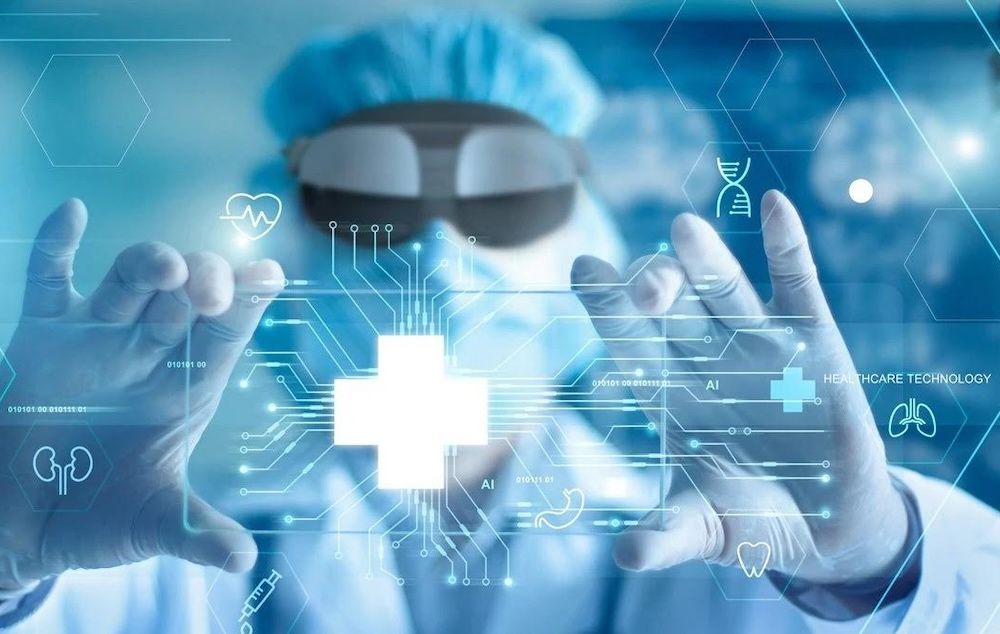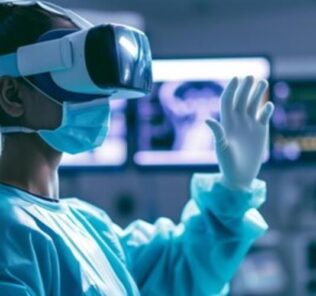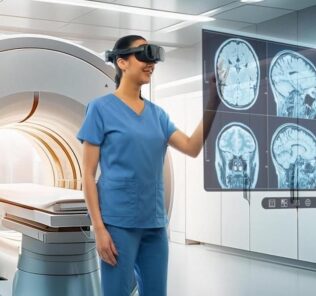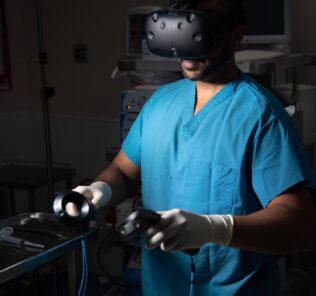HTC Panel on the Current and Future Use of XR and VR
During IMSH 2024, HTC VIVE and HealthySimulation.com co-hosted a special mixer and panel discussion which brought industry, clinical, and academic champions together to network and explore the potential of Extended Reality (XR) to improve clinical simulation outcomes. Leaders from SimX, Virti, and the Cleveland Clinic Sim Center were also present to discuss topics around XR in healthcare and provide Virtual Reality (VR) demonstrations of their medical simulation training content on HTC VIVE headsets. The panel presentation focused on key opportunities of XR and was hosted by HealthySimulation.com Founder/CEO Lance Baily, HTC VIVE Americas President Dan O’Brien, SimX Founder/CEO, Dr. Ryan Ribeira, MD, MPH, Virti CEO Kurt Kratchman, and Nichole C. Brown, PhD(c), MSN, RN, CHSE-A, Senior Simulation Education Specialist at Cleveland Clinic. Read on to hear the panel’s key insights at this special IMSH event!
Why is VR and XR Important?
XR technology can improve clinical training by immersing trainees in realistic behavioral health simulations. It can improve the quality of care by assessing the more effective course of action in the field with remote assistance of the leading specialist anywhere as well as simulate medical procedures and show patients what they can expect before they undergo surgery or other treatments. This can help patients feel more informed and empowered about their care. VR and XR can:
Sponsored Content:
- Improve provider and patient satisfaction and comfort level
- Enhance medical training and education with more accessibility and training on a larger scale
- Expand healthcare access through telehealth
- Reduce cost and complications
- Enhance empathy training
- Create better patient outcomes
- Collect and analyze data – To improve, one must measure and analyze
Integration of XR Technology into Healthcare Simulation
Immersive technologies revolutionize how we learn, how we retain information, how we educate, and how doctors treat patients. The versatile nature of XR allows organizations to customize scenarios based on knowledge gaps, enveloping professionals in virtual environments that offer a diverse array of training scenarios.
In today’s healthcare landscape, the traditional models of training are facing increasing challenges and constraints. As traditional training models become more heavily cost prohibitive, XR is increasingly becoming a more enticing alternative.
For HTC VIVE, it has always been about how humanity converges with technology to benefit society and to have a positive impact on humanity. HTC VIVE is enabling significant leaps in the healthcare space through the use of their XR headsets with partner solutions. Data supports the incorporation of XR into healthcare education. A recent healthcare survey from HTC VIVE also found that a staggering 91% of respondents believe that XR enhances education plans and empowers coordinators to be more effective. PWC found that about one-third of employers (34%) who have used VR training say it is more effective in developing and training their workforce.
Sponsored Content:
However, institutions must determine how to pay for the technology and make it scalable to meet the needs of all stakeholders. Some of the solutions to address these issues are:
- Collaboration with partners to make technology simple, easy, and accessible
- Choosing the right headset and weighing the cost of the high-performance technology with traditional models
- Potential for scalability of technology and solution
Affordability and scalability are the two most important pieces to this high performance technology. Virti CEO Kurt Kratchman discussed their approach in leveraging XR, sharing that “combining these technologies of ecosystem collaboration with HTC and many other partners brings a sort of simple, easy to use approach for those who are trying to get into a technology that historically has been too complicated, too difficult to use, too expensive, and not scalable.”
XR is a tool that can help healthcare simulation organizations increase the simulation frequency with realistic, immersive experiences. This can make healthcare professionals better clinicians, by improving patient safety and outcomes. But not all patient scenarios are readily available for every healthcare professional to learn how to assess, diagnose, treat, and monitor for the best outcomes. Dr. Ribeira, Founder/CEO discussed traditional simulation tools, noting “there’s a lot of limitations especially when it comes to things like rashes, strokes, and psychosocial interactions or environmental complexity…but it is very easy to do in VR.”
In a traditional clinical simulation, the resources to conduct simulation require a mannequin, hospital bed, monitor/defibrillator with leads, IV infusion with monitor, vital sign equipment, oxygen, simulation ops person, a healthcare provider facilitator, lab space, the logistics of scheduling the lab with other courses and interprofessional providers, and the support of the simulation lab. This is not an all-inclusive list. As one can see, this is an expensive, complex endeavor.
With VR, the cost would be the purchase of an XR headset, a healthcare simulation program or scenario, an empty classroom or space, and the support of the simulation lab for maintenance and upkeep of the equipment. The learner and facilitator can now work together or independently to practice anytime. Dr. Riberio also stated he entered the XR clinical simulation space because of his passion for patient safety and quality improvement. He shares that sees XR as “a tool that will help us sim more frequently and sim more realistically and I think it does both of those things very well.”
Leveraging XR for Healthcare Education
XR also has the potential to enhance educational programs to digitally upskill users, address nursing/clinical workforce shortages through expedited and augmented training, and even facilitate preparation for medical procedures via 3D visualization platforms and models.
Interprofessional education (IPE) is a requirement and an essential competency for most healthcare professional education programs. Most IPE opportunities in academic programs include clinical simulation. However, IPE is extremely time-consuming to create buy-in, schedule, and coordinate between disciplines. VR can solve some of the logistical issues and free up both educator time and costs. The versatile nature of XR allows institutions to customize training and education scenarios, increasing efficiency and providing a scalable, cost-effective alternative to traditional training. XR allows participants to learn from multiple campuses, spaces, times, and facilitation.
The panelists discussed the different ways people learn, especially with in-person and virtual learning. XR technology is a flexible and accessible tool for healthcare education and training. Nichole Brown, Cleveland Clinic, compared XR technology preferences to wine preferences, illustrating diversity in learning styles and the importance of multimodal learning options based on the preferred learning style. The end-users become so immersed in the simulation that upon conclusion of the simulation, some participants take off their headsets and say, “Wow, I forgot people were watching me,” according to Brown.
Brown also discussed how using the HTC headset is a much more comfortable experience for her. Brown said, “I’ve been a nurse for 20 plus years. I used to wear a stethoscope around my neck. I now have stenosis and can’t even handle a necklace. But I can be in a headset from HTC for 40 plus minutes without any issues. So….from an end user perspective it is incredibly comfortable.”
View the LEARN CE/CME Platform Webinar How to Select the Right VR Headset for Healthcare Simulation Training to learn more!
Future of VR and XR Technologies in Healthcare and Healthcare Simulation
The full potential of XR healthcare applications has yet to be realized. Each year, there are even more use cases on how XR, and specifically HTC VIVE headsets, are enabling individuals and businesses for better collaboration, surgical training, soft skills development, immersive learning, and more. The panelists discussed the future of VR and XR technologies in healthcare, looking at advancements in healthcare simulation and the role of AI.
The future of XR in healthcare simulation includes predicting advancements in chip technology, biometrics, and the integration of AI for enhanced learning experiences. The question to consider – What is the future and vision of AI, VR, and XR over the next 3-5 years? The panelists identified:
- The need for all processes to come together with more information being moved to the cloud and better processing
- There is a need for more 5G processing and animation
- Passthrough technology allows for versatile experiences
- More adoption in the education space
- Artificial Intelligence (AI) integrated into training simulations
- Advancing eye tracking and biometrics
- Actually delivering cloud-based content over the air to many headsets that are smaller and lighter
- IPE with AR and VR will outpace current practices to develop and deliver true, better IPE so that healthcare teams can learn and practice together to provide standardized care for patients
AI can really enhance conversations in VR. This is an area for technology to explore. The ability to communicate in a generative platform for more natural language and the psychosocial aspect are areas that require a technological focus. Other aspects of clinical simulation are realistic VR experiences. Another area AI can help is to enhance our ability to make new and better scenarios at the touch of a few buttons.
Universally, panelists agreed that we will see AI being leveraged even more for XR in healthcare. AI is already seeing great strides in the implementation of an assistant function, where it has limited creative capacity, but you can converse with it naturally and get answers to your questions. It’s a value add for performance accuracy, by reminding of next steps or flagging if something is out of order on workflow execution. AI can also augment high quality care and service by expanding clinician care from 1:1 to 1:many without degradation of care.
Dan O’Brien said, “Our headsets today use artificial intelligence to make the hand tracking more effective and more accurate. There’s software in those headsets that are actually improving the software based on the users using it every single day.” Privacy and security are also another important factor when it comes to AI, as the encryption that goes along with it is critical. O’Brien continued, “the privacy and security that we put behind the AI makes it stand very differently than any of the other headsets that are out there and how they’re approaching the space.
Virti’s platform was built on AI, and they use it across both the content creation and learner experience sides. Kratchman noted that all of Virti’s analytics are “done through machine learning, which has pretty good analytics on outcomes and performance.” He continued, “when we’re generating content, we use many generative AI tools. Our avatar platform is built on AI. Our AI powered avatars are speaking 20 languages, and all of those are generated by AI.”
The future of XR headsets, will continue to get a lot lighter, a lot easier to deploy, and incorporate 5G. XR can be incorporated into in-person clinical simulations, allowing for overlays to physical mannequins, task trainers, standardized patients, and things like that, which opens a whole new world of possibilities. Dan O’Brien added that, “if you’re asking, should I leave for AR? Should I do VR? Should I invest now? Well, the headsets in the future will actually do all three scenarios. Really think about your future investments. Think about your future partners.”
Dr. Ribeira discussed how advancements in things like eye tracking and biometrics will enable measuring real time stress levels of your students while they’re in sims. He said, “imagine being able to do that and tune your Sim to keep them in that sweet spot of stress. Now, you are training your medical personnel like you are training Olympic athletes that are running on that treadmill, staying in the sweet spot all the time. And I think that is actually just a few years away.”
With the introduction of biometrics, it will bring even more focus on the data and security aspect. SimX’s customers are currently prioritizing this, but Dr. Ribeira says, “it’s going to be even more important in the future as we start taking advantage of the ability that these headsets have to track every movement within a simulation.”
Overall, the conversation showcased a strong belief in the transformative potential of XR technology in healthcare simulation, emphasizing innovation, user experience, and the importance of strategic partnerships for advancing the field. All panelists agreed that XR is part of the future of healthcare education and simulation training. Partnerships and collaboration are critical components in training healthcare professionals, providing safe care, and improving patient outcomes.
About HTC VIVE
HTC VIVE is the premier extended reality (XR) platform and ecosystem that creates true-to-life XR experiences for businesses and consumers. The VIVE ecosystem is built around premium VR hardware, software, and content. The VIVE business encompasses best-in-class XR hardware; VIVEPORT platform and app store; VIVE Enterprise Solutions for business customers; VIVE X, a US$100M VR business accelerator; and VIVE ARTS for cultural initiatives. For more information, please visit www.vive.com.
Virtual Reality hardware provider HTC Vive has recently collaborated with HealthySimulation.com to create several key resources for healthcare professionals considering the use of VR in clinical education and training. By sharing these open-access video podcasts with industry experts, helpful eBooks covering proven use cases, and insightful national survey results, HTC Vive demonstrates the potential of Virtual Reality forever to change the face of clinical education and training, as well as provide helpful strategies and tactics for those looking to deploy these innovative technologies.
Learn More About HTC and How They Can Meet Your Simulation Needs!
Sponsored Content:

















